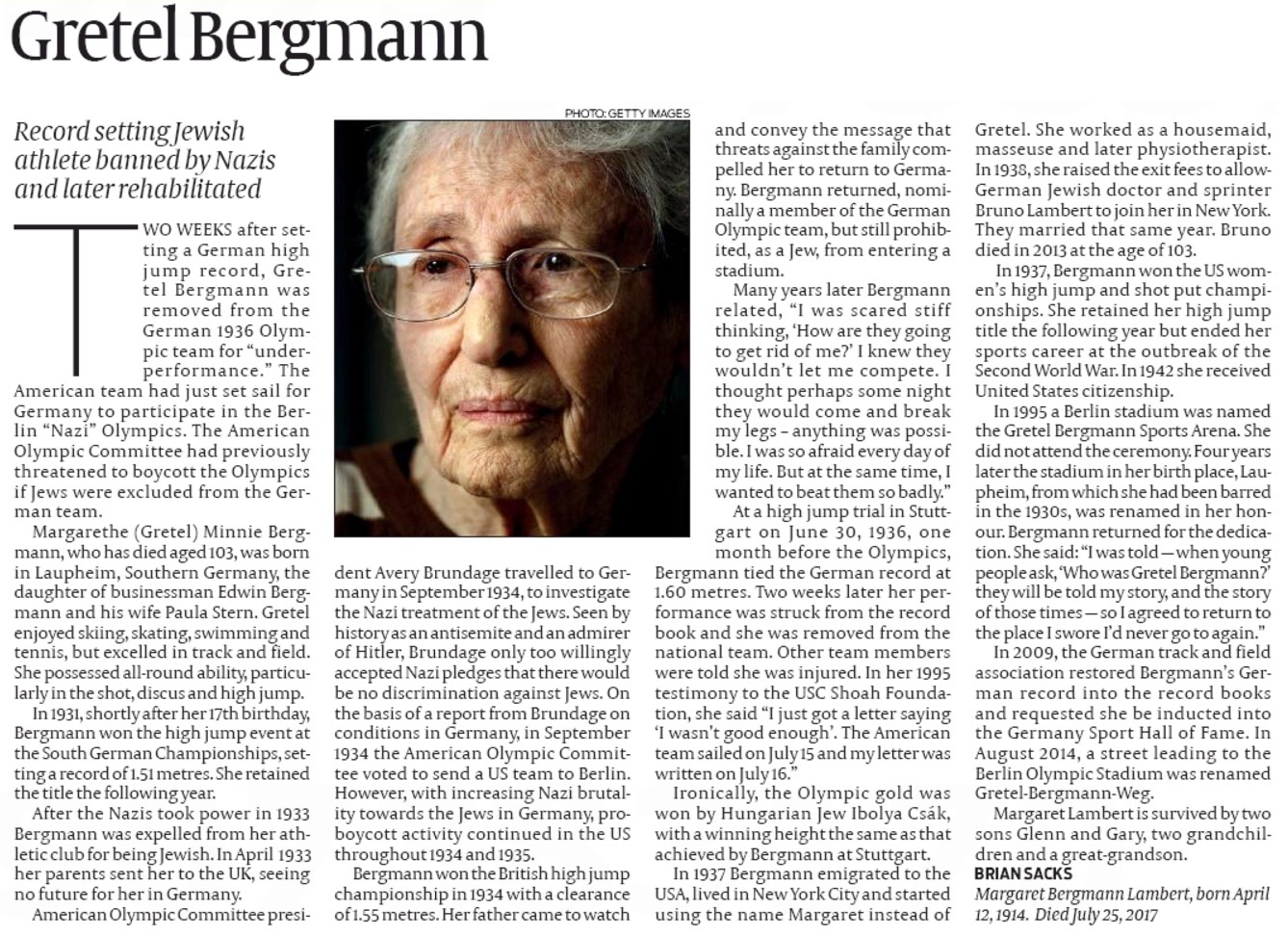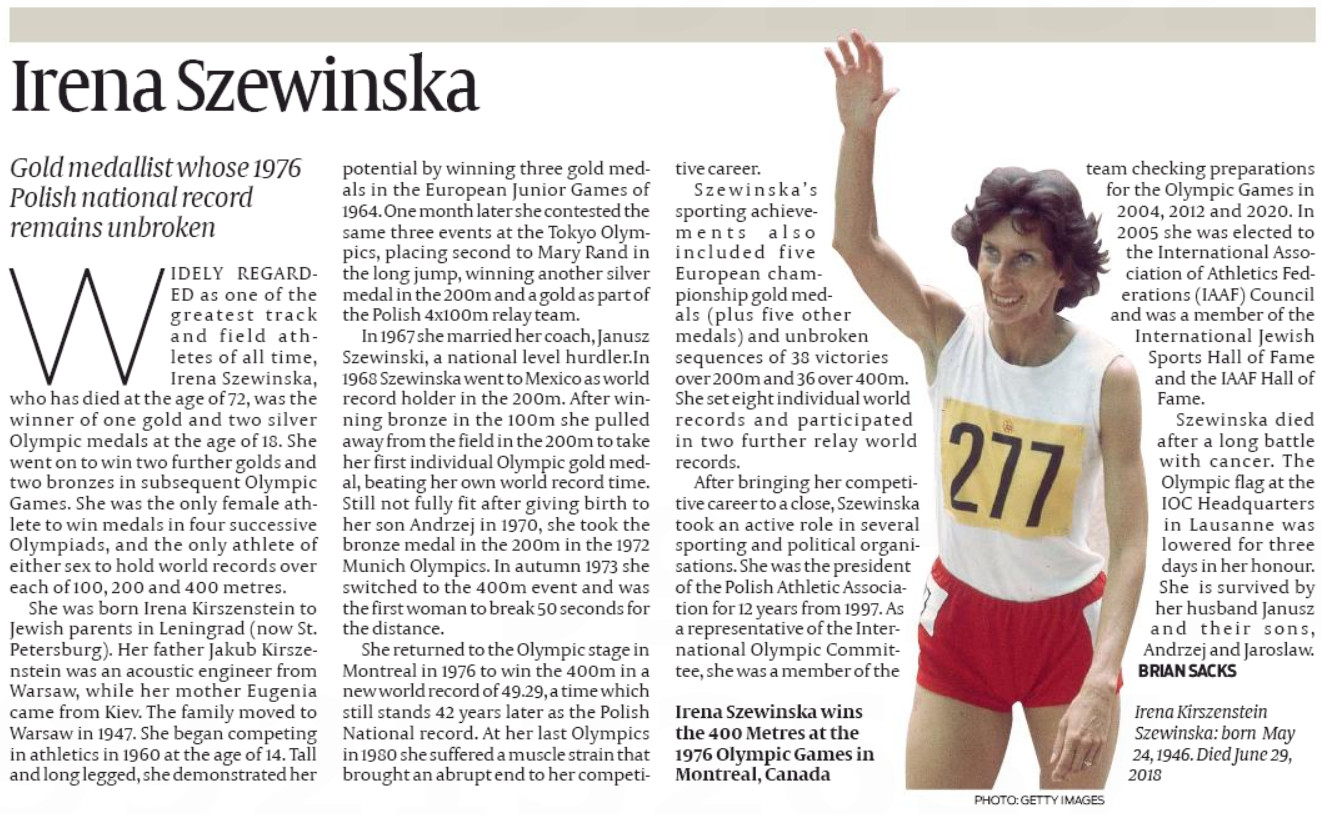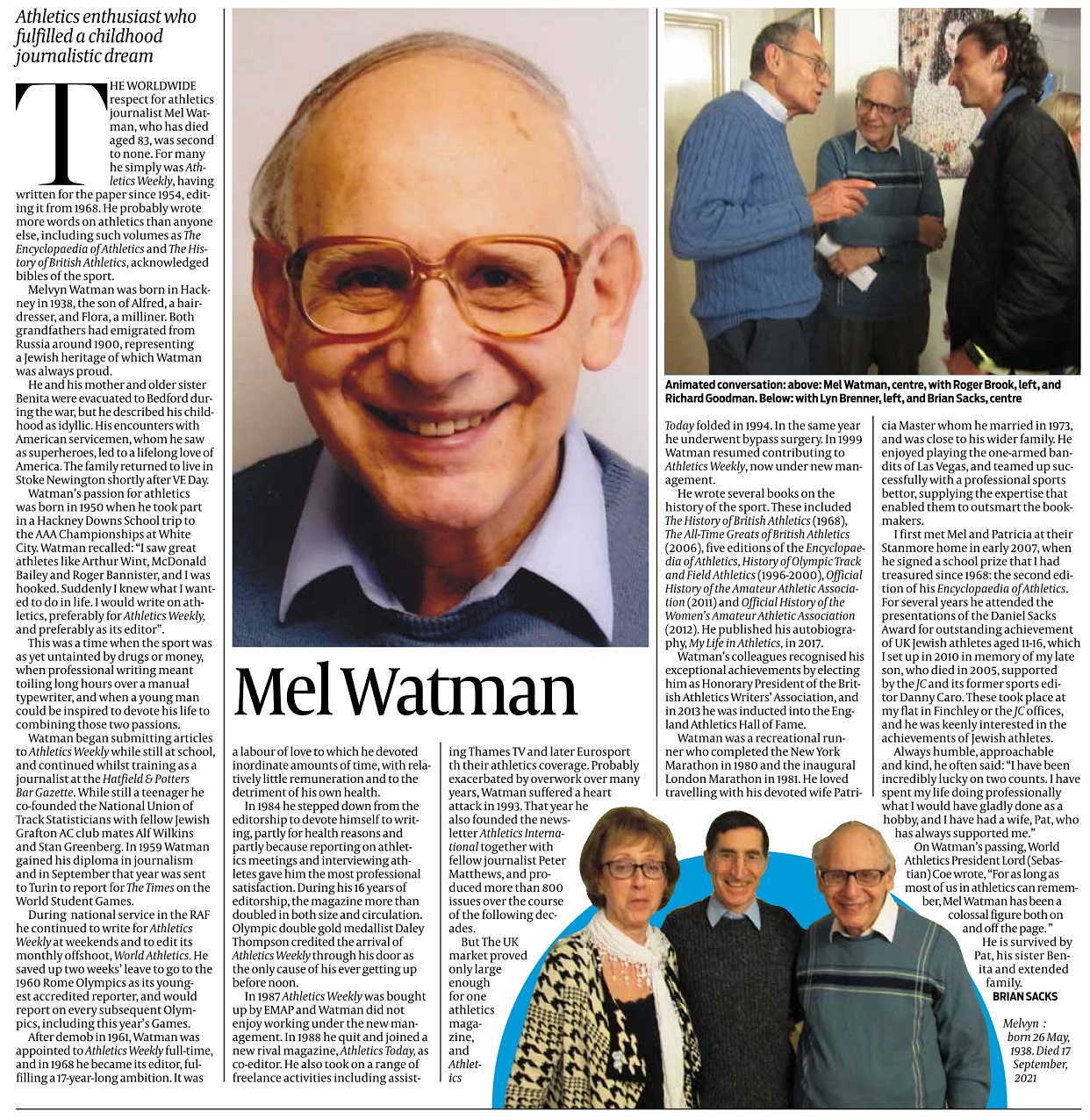|
|
 |
 |
 |
 |
 |
 |
 |
 |
 |
 |
 |
 |
 |
|
In Memoriam
I contributed three obituaries to the Jewish Chronicle that each told the story of a man or woman who left his or her own mark on the history of athletics. The published versions are presented below, in each case followed by the submitted plain text of the obituary.
|
|
|
|
Gretel Bergmann 1914 - 2017
Irena Szewinska 1946 - 2018
Mel Watman - 1938 - 2021
|
|
|
|
Gretel Bergmann 1914 - 2017
|
|
|
|
 |
|
|
Gretel Bergmann 1914 - 2017: Text version
|
|
|
|
Two weeks after setting a German high jump record, Gretel Bergmann was removed from the German 1936 Olympic team for "underperformance". The American team had just set sail for Germany to participate in the Berlin "Nazi" Olympics. The American Olympic Committee had previously threatened to boycott the Olympics if Jews were excluded from the German team.
Margarethe (Gretel) Minnie Bergmann was born in Laupheim, Southern Germany, the daughter of businessman Edwin Bergmann and his wife Paula Stern. Gretel enjoyed skiing, skating, swimming and tennis, but excelled in track and field. She possessed all-round ability, particularly in the shot, discus and high jump.
In 1931, shortly after her 17th birthday, Bergmann won the high jump event at the South German Championships, setting a national record of 1.51 metres. She retained the title the following year.
After the Nazis took power in 1933 Bergmann was expelled from her athletic club for being Jewish. In April 1933, Bergmann's parents sent her to the United Kingdom, seeing no future for her in Germany.
By 1934, America was threatening an Olympic boycott if Jews were excluded from the German team. American Olympic Committee president Avery Brundage travelled to Germany in September 1934 to investigate the Nazi treatment of the Jews. Seen by history as an anti-semite and an admirer of Hitler, Brundage only too willingly accepted Nazi pledges that there would be no discrimination against Jews. On the basis of a report from Brundage on conditions in Germany, in September 1934 the American Olympic Committee voted to send a US team to Berlin. However, with increasing Nazi brutality towards the Jews in Germany, pro-boycott activity continued in the United States throughout 1934 and 1935.
Bergmann won the British high jump championship in 1934 with a clearance of 1.55 metres. Her father came to watch, and to convey the message that threats made against the family compelled her to return to Germany. Bergmann returned, nominally a member of the German Olympic team, but still prohibited, as a Jew, from entering a stadium.
Many years later Bergmann related, "I was scared stiff thinking, ‘How are they going to get rid of me?’. I knew they wouldn't let me compete. I thought perhaps some night they would come and break my legs – anything was possible. I was so afraid every day of my life. But at the same time, I wanted to beat them so badly."
At a high jump trial in Stuttgart on 30 June 1936, one month before the Olympics, Bergmann tied the German record at 1.60 metres. Two weeks later her performance was struck from the record book and she was removed from the national team. Other team members were told that she was injured. In her 1995 testimony to the USC Shoah Foundation, she said "I just got a letter saying ‘I wasn't good enough’. The American team sailed on July 15 and my letter was written on July 16."
Ironically, the Olympic gold was won by Hungarian Jewess Ibolya Csák, with a winning height the same as that achieved by Bergmann at Stuttgart.
In 1937 Bergmann emigrated to the USA, lived in New York City and started using the name Margaret instead of Gretel. She worked as a housemaid, masseuse and later as a physiotherapist. In 1938, Bergmann raised the exit fees to allow German Jewish doctor Bruno Lambert, a sprinter himself, to also emigrate to New York. Bergmann and Lambert married that same year. Their marriage lasted for 75 years, until Bruno died in 2013 at the age of 103.
In 1937, Bergmann won the US women's high jump and shot put championships. She retained her high jump title the following year, but ended her sports career at the outbreak of World War II. In 1942, she received United States citizenship.
In 1995 a Berlin stadium was named the Gretel Bergmann Sports Arena. Bergmann did not attend the ceremony. Four years later, the stadium in her birth place, Laupheim, from which she had been barred in the 1930s, was renamed the Gretel Bergmann Stadium. Bergmann returned for the dedication. She said: "I was not going to participate, but I was told that they were naming the facilities for me so that when young people ask, 'Who was Gretel Bergmann?' they will be told my story, and the story of those times. I felt it was important to remember, and so I agreed to return to the place I swore I'd never go to again."
In 2009, the German track and field association restored Bergmann’s German record into the record books and requested that she be inducted into the Germany Sport Hall of Fame. In August 2014, one of the streets leading to the Berlin Olympic Stadium was renamed Gretel-Bergmann-Weg.
Margaret Lambert is survived by two sons, Glenn and Gary; two grandchildren; and a great-grandson.
Margaret Bergmann Lambert, born April 12, 1914, died July 25, 2017.
|
|
|
|
Irena Szewinska 1946 - 2018
|
|
|
|
 |
|
|
|
Irena Szewinska 1946 - 2018: Text Version
|
|
|
|
Irena Szewinska is widely regarded as one of the greatest track and field athletes of all time. Winning one gold and two silver Olympic medals at the age of 18, she went on to win two further golds and two bronzes in subsequent Olympic Games. She was the only female athlete to ever win medals in four successive Olympiads, and the only athlete of either sex to hold world records over each of 100, 200 and 400 metres.
Irena Kirszenstein was born to Jewish parents in Leningrad (now St. Petersburg) on May 24, 1946. Her father, Jakub Kirszenstein was an acoustic engineer from Warsaw, while her mother, Eugenia came from Kiev. The family moved to Warsaw in 1947.
Kirszenstein began competing in athletics in 1960 at the age of 14. Tall and long legged, she demonstrated her potential by winning three gold medals in the European Junior Games of 1964. One month later she contested the same three events at the Tokyo Olympics, placing second to Mary Rand in the long jump, winning another silver medal in the 200m and a gold as part of the Polish 4x100m relay team.
In 1967 Kirszenstein married her coach, Janusz Szewinski, a national level hurdler.
In 1968 Szewinska went to Mexico as world record holder in the 200m. After winning bronze in the 100m she pulled away from the field in the 200m to take her first individual Olympic gold medal, beating her own world record time. Still not fully fit after giving birth to her son Andrzej in 1970, she took the bronze medal in the 200m in the 1972 Munich Olympics. In autumn 1973 she switched to the 400m event and was the first woman to break 50 seconds for the distance. She returned to the Olympic stage in Montreal in 1976 to win the 400m in a new world record of 49.29, a time which still stands 42 years later as the Polish National record. At her last Olympics in 1980 she suffered a muscle strain that brought an end to her competitive career.
Szewinska’s sporting achievements also included five European championship gold medals (and five other medals) and unbroken sequences of 38 victories over 200m and 36 over 400m. She set eight individual world records and participated in two further relay world records.
After bringing her competitive career to a close, Szewinska took an active role in several sporting and political organizations. She was the president of the Polish Athletic Association for 12 years from 1997. As a representative of the International Olympic Committee, she was a member of the team checking the state of preparations for the Olympic Games in 2004, 2012 and 2020. In 2005 she was elected to the International Association of Athletics Federations (IAAF) Council.
She was an inductee of the International Jewish Sports Hall of Fame and the IAAF Hall of Fame.
Szewinska died at the age of 72 after a long battle with cancer. The Olympic flag at the IOC Headquarters in Lausanne was lowered for three days in her honour.
Irena Kirszenstein Szewinska, born 24 May 1946, died 29 June 2018
Irena Szewinska is survived by her husband Janusz Szewinski and two sons, Andrzej and Jaroslaw.
|
|
|
|
Mel Watman 1938 - 2021
|
|
|
|
 |
|
|
|
Mel Watman 1938 - 2021: Text Version
|
|
|
|
Mel Watman probably wrote more words on athletics than anyone else. Volumes such as "The Encyclopaedia of Athletics" and "The History of British Athletics" were acknowledged to be bibles of the sport. Writing for Athletics Weekly since 1954, and editing it for 16 years from 1968, for many people he simply was Athletics Weekly. The worldwide respect for Watman as an athletics journalist was second to none.
Melvyn Watman was born in Hackney in 1938. His parents Alfred, a hairdresser, and Flora, a milliner, were born in England, but both of Watman’s grandfathers had immigrated from Russia around 1900. They represented a Jewish heritage of which Watman was always proud.
Melvyn, together with his mother and his older sister Benita, was evacuated to Bedford during the war, but he described his childhood as idyllic. His encounters with American servicemen, who he saw as superheroes, led to a lifelong love of America. The family returned to live in Stoke Newington shortly after VE day.
Watman’s passion for athletics was born in 1950 when he took part in a Hackney Downs School trip to the AAA Championships at the White City. Watman recalled, "I saw great athletes like Arthur Wint, McDonald Bailey and Roger Bannister, and I was hooked. Suddenly I knew what I wanted to do in life. I would write on athletics, preferably for Athletics Weekly, and preferably as its editor".
This was a time when the sport was as yet untainted by drugs or money, when professional writing meant toiling long hours over a manual typewriter, and when a young man could be inspired to devote his life to combining those two passions.
Watman began submitting articles to Athletics Weekly while still at school, and continued whilst training as a journalist at the Hatfield & Potters Bar Gazette. While still a teenager he co-founded the National Union of Track Statisticians with fellow Jewish Grafton AC clubmates Alf Wilkins and Stan Greenberg. In 1959 Watman gained his diploma in journalism and in September that year was sent to Turin to report for The Times on the World Student Games.
Watman returned from Turin to begin national service in the RAF, but continued to write for Athletics Weekly at weekends and to edit its monthly offshoot ‘World Athletics’. He saved up two weeks’ leave to go to the 1960 Rome Olympics as its youngest accredited reporter. Watman was to report on every subsequent Olympics, including this year's.
After his demob in 1961 Watman was appointed to Athletics Weekly full-time, and in 1968 he became its editor, fulfilling his ambition of 17 years previously. It was a labour of love to which he devoted inordinate amounts of time, with relatively little remuneration and to the detriment of his own health. In 1984 he stepped down from editorship to devote himself more completely to writing, partly for health reasons and partly because reporting on athletics meetings and interviewing athletes gave him the most professional satisfaction. During his 16 years of editorship, the magazine had more than doubled in both size and circulation. Olympic double gold medallist Daley Thompson credited the arrival of Athletics Weekly through his door each Friday as the only cause of his ever getting up before noon.
In 1987 Athletics Weekly was bought up by EMAP and Watman did not enjoy working under the new management. In 1988 he quit and joined a new rival magazine, Athletics Today, as co-editor. He also took on a range of freelance activities including assisting Thames TV and later Eurosport and Sky Sports with their athletics coverage. The UK market proved to be only large enough for one athletics magazine, and Athletics Today folded in 1994. Probably exacerbated by overwork over many years, Watman suffered a heart attack in 1993 and underwent bypass surgery the following year. In 1993 he founded the newsletter Athletics International together with fellow journalist Peter Matthews, and produced more than 800 issues over the course of the following decades. In 1999, Watman resumed contributing to Athletics Weekly, now under new management.
Watman wrote several books on the history of the sport. These included "The History of British Athletics "(1968), “The All-Time Greats of British Athletics"(2006), five editions of the Encyclopaedia of Athletics, "History of Olympic Track and Field Athletics" (1996, 2000), “Official History of the Amateur Athletic Association” (2011) and “Official History of the Women's Amateur Athletic Association” (2012). He wrote the autobiographical "My Life in Athletics" in 2017.
Watman’s colleagues recognised his exceptional achievements by electing him as Honorary President of the British Athletics Writers' Association, and in 2013 he was inducted into the England Athletics Hall of Fame.
Watman was a recreational runner who completed the New York Marathon in 1980 and the inaugural London Marathon in 1981. He loved travelling with his devoted wife Pat, and was very close with, and generous towards, his wider family. He enjoyed playing the one-armed bandits of Las Vegas, and teamed up successfully with a professional sports better, supplying the expertise that enabled them to outsmart the bookmakers.
On the first occasion that I met Mel and Pat at their Stanmore home, in early 2007, he signed a school prize that I had treasured since 1968: the Second Edition of his Encyclopaedia of Athletics. For several years he attended the presentations of the Daniel Sacks Athletics Awards taking place at my flat in Finchley or at the Jewish Chronicle Offices, and he was keenly interested in Jewish athletes and their achievements. He was always humble, approachable and kind. He often stated, "I have been incredibly lucky on two counts. I have spent my life doing professionally what I would have gladly done as a hobby, and I have had a wife, Pat, who has always supported me completely."
On Watman's passing, World Athletics President Lord Sebastian Coe wrote, “For as long as most of us in athletics can remember, Mel Watman has been a colossal figure both on and off the page. Informed, insightful and passionate; a life lived through athletics. He will be missed.”
Melvyn Watman, 26 May 1938 – 17 September 2021
Survived by his wife Pat; sister Benita and her husband Charles Sharon; niece Sandra Hardman; nephew Lionel and his wife Bernadetta Sharon; Great nephew and nieces Michael Hardman and his wife Zena Christoforou; Daniel Hardman; Natalia and Anthony Sharon.
|
|
|


